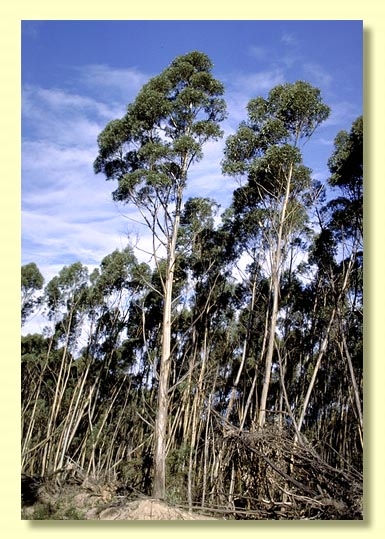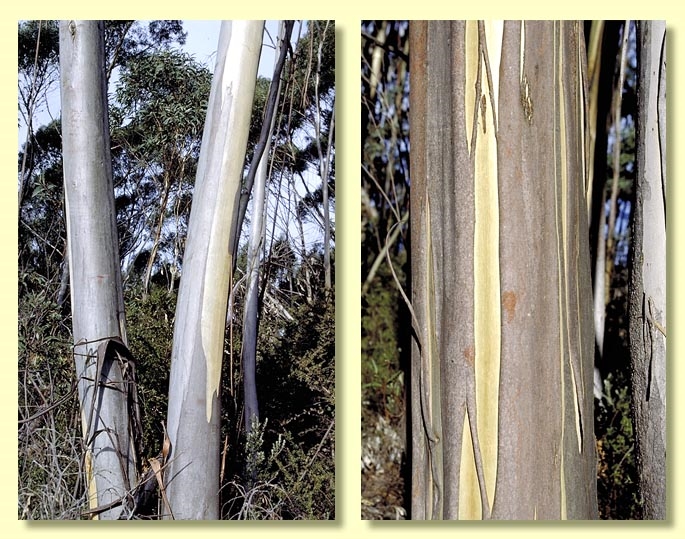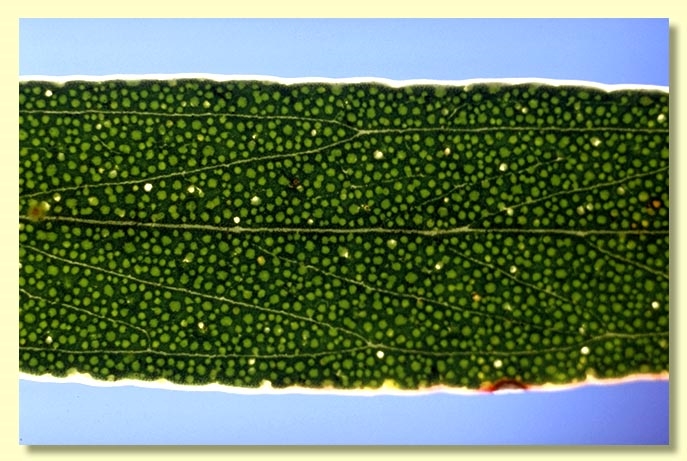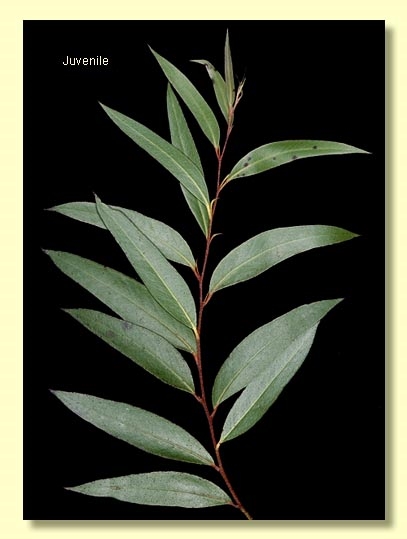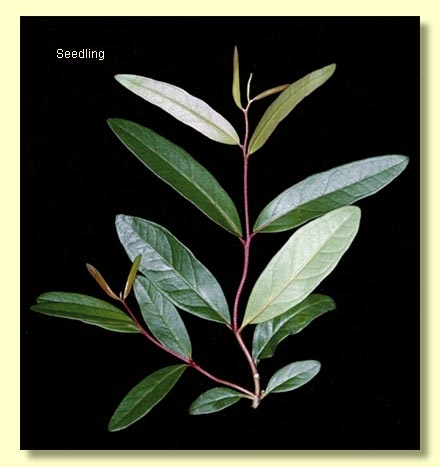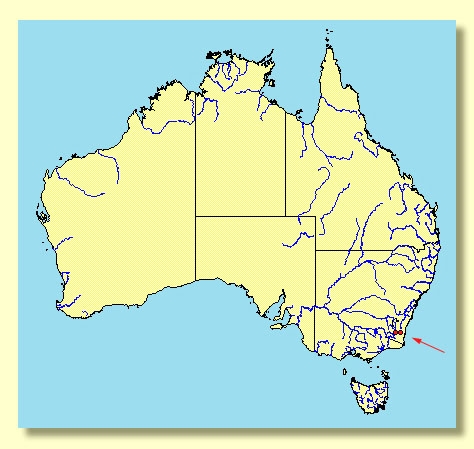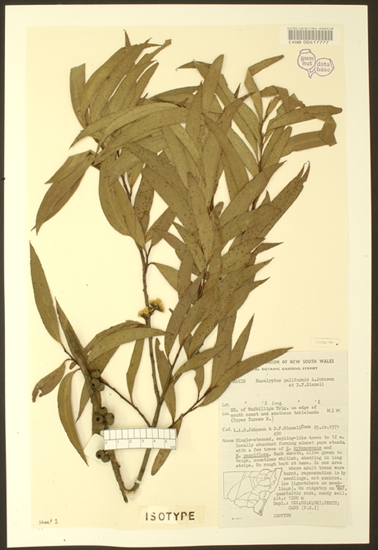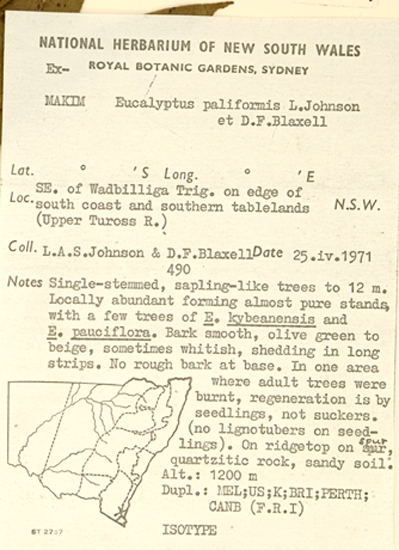Euclid - Online edition
Eucalyptus paliformis
Eucalyptus | Eucalyptus | Eucalyptus | Strictae | Regulares
Bark smooth throughout, grey to green or white with newly exposed bark yellow.
Juvenile growth (coppice or field seedlings to 50 cm): stems rounded in cross-section, warty; juvenile leaves opposite, subsessile, elliptic to ovate and discolorous for 3 to 5 nodes then alternate, petiolate, lanceolate to narrowly lanceolate, 6.5–11 cm long, 1.5–2 cm wide, concolorous, glossy, dark green above.
Adult leaves alternate, petiole 0.5–1.2 cm long; blade lanceolate to falcate, (6.2)7–13 cm long, 0.9–2 cm wide, base oblique or tapering to petiole, margin entire or subcrenulate, concolorous, glossy, green, side-veins acute, reticulation sparse or absent, intramarginal vein parallel to and remote from margin, oil glands island.
Inflorescence axillary unbranched, peduncles 0.4–0.8 cm long, buds 7 per umbel, pedicels 0.1–0.4 cm long. Mature buds obovoid, 0.5 cm long, 0.3 cm wide, warty, scar absent, operculum conical to rounded, stamens irregularly flexed, anthers reniform to cordate, versatile, dorsifixed, dehiscing by confluent slits, style long, stigma tapered, locules 3 or 4, the placentae each with 2 vertical ovule rows. Flowers white.
Fruit on pedicels 0.1–0.4 cm long, truncate-globose, 0.6–0.8 cm long, 0.5–0.7 cm wide, disc descending, valves 3 or 4, enclosed.
Seeds brown, 1.5–2.2 mm long, pyramidal or obliquely pyramidal, dorsal surface smooth, hilum terminal.
Cultivated seedlings (measured at ca node 10): cotyledons reniform; stems rounded in cross-section, warty (feel rough); leaves at first sessile, opposite, ovate-elliptic and discolorous for 3 to 5 nodes, then alternate, shortly petiolate, lanceolate, 6.5–12 cm long, 1–2 cm wide, tapering to rounded at base, slightly discolorous, very glossy, green.
Flowering has been recorded in May, June and July.
A small to medium-sized tree known only from a few populations in the Wadbilliga area north-east of Cooma in south-eastern New South Wales.
Eucalyptus paliformis is a green-leaved ash species with smooth bark, green glossy juvenile and adult leaves and brown seeds. It has been confused with E. fraxinoides, a blue-leaved ash species which always has a black rough butt, larger bluish green juvenile leaves and glossy green adult leaves, larger buds and fruit and black seeds. E. paliformis could be confused with other smooth-barked, green-leaved ash trees, e.g. E. dendromorpha and E. triflora,both of which occur sporadically on sandstone country well to the north of Wadbilliga, but these have very irregular oil glands in the leaves compared with the almost round glands in E. paliformis, and in E. triflora have buds only in 3s, rarely in 3s and 7s. The glossy green-leaved mallee E. kybeanensis does occur within the range of E. paliformis and differs in having sessile globular buds and fruit with an obviously ascending disc (descending disc in E. paliformis).
Eucalyptus paliformis belongs in Eucalyptus subgenus Eucalyptus section Eucalyptus series Strictae, because of a combination of characters: mallee habit with smooth bark, alternate, green juvenile leaves, adult leaves with acute side-veins and little or no visible reticulation, single axillary inflorescences, the buds in clusters of seven or nine, with buds having only one operculum and reniform anthers, ovules in two rows, and more or less pyramidal seeds. Within series Strictae, E. approximans, E. cunninghamii and E. paliformis form a small group, subseries Regulares, characterised by the leaf oil glands being round in outline.

